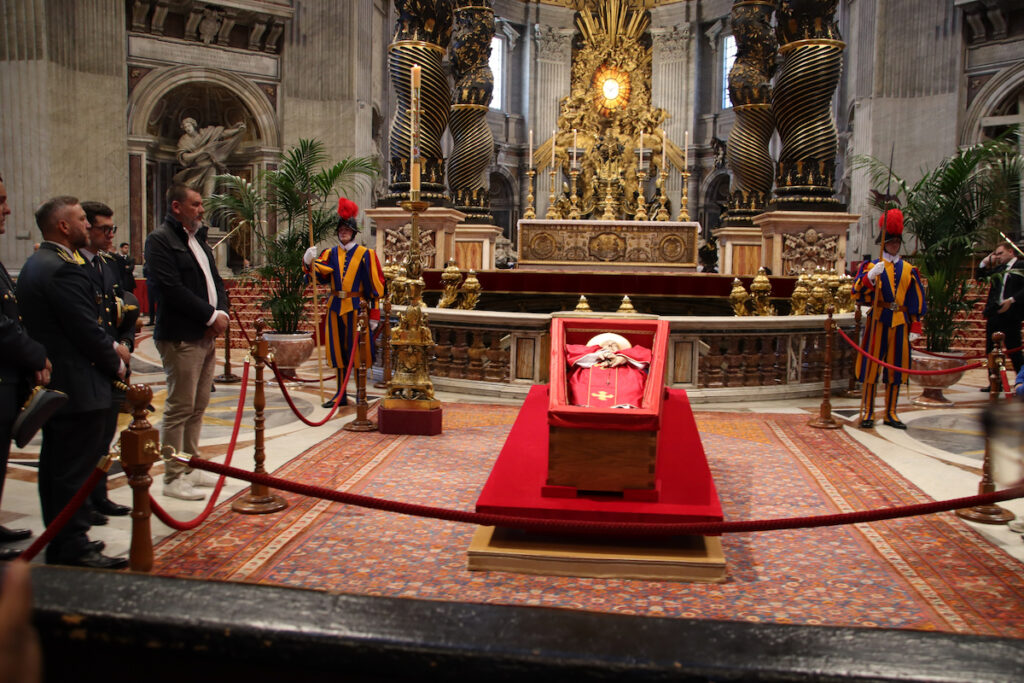Massive Crowds Gather in Rome
The Vatican made the rare decision to keep St. Peter’s Basilica open throughout the night after an unexpectedly high turnout of mourners arrived to pay final respects to Pope Francis. The late pontiff, who died at 88 following a stroke, now lies in state in a modest wooden casket inside the grand basilica, surrounded by the quiet devotion of the faithful.
Crowds began forming before dawn and have continued growing since. Visitors waited in long, slow-moving lines that extended down the Via della Conciliazione, through St. Peter’s Square, and into the basilica via the Holy Door. The basilica itself remained open for more than 24 hours straight, closing briefly only from 5:30 a.m. to 7:00 a.m. Thursday morning for cleaning and preparations.
Some pilgrims waited for hours just for a few seconds before the casket. “I don’t care how long it takes,” said a Mexican mourner standing in line past midnight. “This is my way of saying thank you.” Others, like an Irish pilgrim who flew in for a single day, said the journey was spontaneous but necessary — a final gesture of appreciation for a pope whose values transcended borders.
By early afternoon Thursday, the Vatican reported that more than 61,000 people had filed through the basilica, with many more expected before the funeral scheduled for Saturday.
Remembering a Legacy of Inclusion
Pope Francis will be remembered not only for his role as a spiritual leader but also for his message of humility, inclusion, and mercy. His 12-year papacy resonated deeply with Catholics and non-Catholics alike, particularly for his outreach to the poor, refugees, and marginalized communities.
His death prompted a wave of international visitors, including families who brought children to witness the historical moment. “We never had the chance to see him alive,” one woman explained while exiting the basilica with her three young children. “But we wanted them to remember this.”
Many spoke of how Francis had helped shift the tone of the Catholic Church — fostering open discussion, compassion, and modernization without straying from tradition. “He made people feel welcomed, no matter their background,” said a French pilgrim who works with disabled children. “Being here feels like honoring that spirit.”
The pope’s body lies on a slightly elevated platform with four Swiss Guards standing at attention. Some in the crowd paused to pray. Others wiped away tears. The basilica echoed with reverent silence interrupted only by hushed whispers and the occasional sound of footsteps.
Final Farewell and Funeral Preparations
The funeral Mass will take place in St. Peter’s Square on Saturday, drawing heads of state, religious leaders, and thousands of attendees. According to the Vatican, 130 official delegations have confirmed their presence, including 50 heads of state and 10 reigning monarchs. Among those scheduled to attend are U.S. President Donald Trump and Ukrainian President Volodymyr Zelenskyy.
Security measures around the Vatican have been significantly reinforced. Italian authorities have mobilized a wide array of resources, including drones, mounted police, and foot patrols to monitor the area. Special attention is being paid to the Tiber River banks and the surrounding streets leading into Vatican City.
After the Mass, Pope Francis will be laid to rest inside the St. Mary Major Basilica, where he often prayed and expressed deep devotion to the Madonna. This decision reflects his personal humility and spiritual connection to that sacred space, rather than the traditional burial location under St. Peter’s.
Looking Ahead: The Church in Transition
As the faithful reflect on Francis’ life, the Church is also preparing for its next chapter. By Thursday, 113 cardinals had arrived in Rome to attend the funeral and participate in preliminary discussions. While official talks regarding succession have not begun, informal conversations have reportedly touched on the challenges and direction ahead for the Church.
The formal conclave to elect a new pope is expected to begin no earlier than May 5, following nine days of official mourning. Only cardinals under the age of 80 will be eligible to vote, narrowing the field to 133 electors, after two cardinals cited health concerns for their absence.
For now, though, the global Catholic community remains focused on mourning. In the basilica and the streets beyond, the air is filled not with despair but with appreciation. Pope Francis’ legacy is evident in the thousands of diverse people who have come together in peace — a testament to the unity he championed throughout his papacy.



